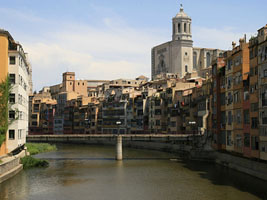 |
Spain | Travel | Regions | Cities | Coasts | Islands | Culture |
| Spain / Catalonia / Costa Brava / Girona |
|
| More Information | ||
| Destinations | ||
| Plan your Trip | ||
| ||||||
 The capital of the Costa Brava, Girona (in Spanish: Gerona) is located about 100 km north of Barcelona and 60 Km. from France. Girona was founded already by the Romans, its latin name was Gerunda.
The capital of the Costa Brava, Girona (in Spanish: Gerona) is located about 100 km north of Barcelona and 60 Km. from France. Girona was founded already by the Romans, its latin name was Gerunda.The historic center is surroudned by thick walls, and is worth visiting because it is very well conserved. Here are the most important monuments: The Cathedral of Santa Maria At the same square we find as well two beautiful buildings: the Renaissance Palace of Justice, "Casa Pastors", and the "Pia Almoina" Worth seeing is also the former jewish quarter Juderia (also "Call Jueu") The Moorish Bathes Girona is crossed by the river Oņar, the part on the right bank is called "Barrio Viejo", the one on the left bank "Barrio de Mercadal". The two parts of the town are linked by four bridges, of which the stone bridge "Pont de Isabel II", from 1849, and the iron bridge "Pont de Eiffel" A very characteristic part of Girona are also the "Casas del Oņar" |